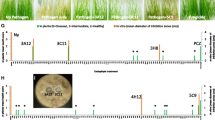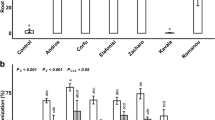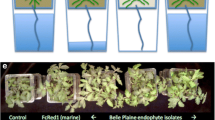Abstract
Some fungal endophytes confer novel phenotypes and enhance existing ones in plants, including tolerance to water deprivation stress. A range of fungal endophytes was isolated from wild Nicotiana plants growing in arid parts of northern Australia. These were screened for ability to enhance water deprivation stress tolerance by inoculating seedlings of the model plant N. benthamiana in two in vitro tests. Sixty-eight endophyte isolates were co-cultivated with N. benthamiana seedlings on either damp filter paper or on agar medium before being subjected to water deprivation. Seventeen isolates were selected for further testing under water deprivation conditions in a sand-based test in a glasshouse. Only two fungal isolates, Cladosporium cladosporioides (E-162) and an unknown fungus (E-284), significantly enhanced seedling tolerance to moisture deprivation consistently in both in vitro and sand-based tests. Although a strongly significant correlation was observed between any two screening methods, the result of filter paper test was more strongly reflected (r = 0.757, p < 0.001) in results of the glasshouse test, indicating its relative suitability over the agar-based test. In another experiment, the same 17 isolates carried forward to the sand-based test used in the glasshouse screening test were inoculated to N. benthamiana plants in pots in a nutrient-limiting environment to test their influence on growth promotion. Isolates related to C. cladosporioides, Fusarium equiseti, and Thozetella sp. promoted seedling growth by increasing shoot length and biomass. The fungal isolate E-162 (C. cladosporioides) significantly enhanced moisture deprivation tolerance as well as promoted seedling growth.










Similar content being viewed by others
References
Abarenkov K, Nilsson RH, Larsson K-H, Alexander IJ, Eberhardt U, Erland S, Høiland K, Kjøller R, Larsson E, Pennanen T, Sen R, Taylor AFS, Tedersoo L, Ursing BM, Vrålstad T, Liimatainen K, Peintner U, Kõljalg U (2010) The UNITE database for molecular identification of fungi-recent updates and future perspectives. New Phytol 186:281–285
Arechavaleta M, Bacon CW, Hoveland CS, Radcliffe DE (1989) Effect of the tall fescue endophyte on plant response to environmental stress. Agron 81:83–90
Bacon CW, White JF (2000) Microbial endophytes. Marcel Dekker, Inc., New York
Baker R, Elad Y, Chet I (1984) The controlled experiment in the scientific method with special emphasis on biological control. Phytopathology 74:1019–1021
Bayman P (2007) Fungal endophytes. In: Kubicek CP, Druzhinina IS (eds) The mycota IV: environmental and microbial relationships, 2nd edn. Springer-Verlag, New York
Carroll G (1988) Fungal endophytes in stems and leaves- from latent pathogen to mutualistic symbiont. Ecology 69:2–9
Chang YC, Baker R, Kleifeld O, Chet I (1986) Increased growth of plants in the presence of the biological control agent Trichoderma harzianum. Plant Dis 70:145–148
Chung CL, Longfellow JM, Walsh EK, Kerdieh Z, Van Esbroeck G (2010) Resistance loci affecting distinct stages of fungal pathogenesis: use of introgression lines for QTL mapping and characterization in the maize–Setosphaeria turcica pathosystem. BMC Plant Biol 10:103
Clay K, Holah J (1999) Fungal endophyte symbiosis and plant diversity in successional fields. Science 285:1742–1744
Cong GQ, Yin CL, He BL, Li L, Gao KX (2015) Effect of the endophytic fungus Chaetomium globosum ND35 on the growth and resistance to drought of winter wheat at the seedling stage under water stress. Acta Ecol Sin 35:6120–6128
Dangl JL, Jones JD (2001) Plant pathogens and integrated defence responses to infection. Nature 411:826–833
Engelbrecht BMJ, Comita L, Condit R, Kursar TA, Tyree MT, Turner BL, Hubbell SP (2007) Drought sensitivity shapes species distribution patterns in tropical forests. Nat 447:80–83
Fisher PJ, Petrini O (1992) Fungal saprobes and pathogens as endophytes of rice (Oryza sativa L.). New Phytol 120:137–143
Goodin MM, Zaitlin D, Naidu RA, Lommel SA (2008) Nicotiana benthamiana: its history and future as a model for plant-pathogen interactions. Mol Plant Microbe Interact 21:1015–1026
Harman GE, Howell CR, Viterbo A, Chet I, Lorito M (2004) Trichoderma species: opportunistic avirulent plant symbionts. Nat Rev Microbiol 2:43–56
Herrera J, Khidir HH, Eudy DM, Porras-Alfaro A, Natvig DO, Sinsabaugh RL (2010) Shifting fungal endophyte communities colonize Bouteloua gracilis: effect of host tissue and geographical distribution. Mycologia 102:1012–1026
Hopper SD, Brown AP, Marchant NG (1997) Plants of Western Australian granite outcrops. J R Soc West Austral 80:141–158
Hubbard M, Germida JJ, Vujanovic V (2014) Fungal endophytes enhance wheat heat and drought tolerance in terms of grain yield and second-generation seed viability. J Appl Microbiol 116:109–122
Hyakumachi M, Kubota M (2003) Fungi as plant growth promoter and disease suppressor. In: Arora DK (ed) Fungal Biotechnology in Agricultural, Food and Environmental Application. Marcel Dekker, CRC Press, pp 101–110
Long HH, Schmidt DD, Baldwin IT (2008) Native bacterial endophytes promote host growth in a species-specific manner; phytohormone manipulations do not result in common growth responses. PLoS One 3:e2702
Lugo MA, Reinhart KO, Menoyo E, Crespo EM, Urcelay C (2015) Plant functional traits and phylogenetic relatedness explain variation in associations with root fungal endophytes in an extreme arid environment. Mycorrhiza 25:85–95
Malinowski DP, Belesky DP (2000) Adaptations of endophtye-infected cool-season grasses to environmental stresses: mechanisms of drought and mineral stress tolerance. Crop Sci 40:923–940
Marasco R, Rolli E, Ettoumi B, Vigani G, Mapelli F, Borin S, Abou- Hadid AF, El-Behairy UA, Sorlini C, Cherif A, Zocchi G, Daffonchio D (2012) A drought resistance-promoting microbiome is selected by root system under desert farming. PLoS One 7:e48479
Millar CS (1980) Infection processes on conifer needles. In: Blakeman JP (ed) Microbial ecology of the phylloplane. Academic Press, London, pp 185–209
Miller JD, MacKenzie S, Foto M, Adams GW, Findlay JA (2002) Needles of white spruce inoculated with rugulosin-producing endophytes contain rugulosin reducing spruce budworm growth rate. Mycol Res 106:471–479
Moran NA (2006) Symbiosis. Curr Biol 16:R866–R871
Morillo K, Rodríguez I, Mazzani C, Trujillo de Leal A (2011) Mycobiota associated with grains of rice harvested in cycles of drought and rainfall in Guárico State Venezuela. Fitopatol Venez 24:42–45
Paul D, Park KS (2013) Identification of volatiles produced by Cladosporium cladosporioides CL-1 a fungal biocontrol agent that promotes plant growth. Sensors 13:13969–13977
Pepper M, Keogh JS (2014) Biogeography of the Kimberley Western Australia: a review of landscape evolution and biotic responses in an ancient refugium. J Biogeog 41:1443–1455
Redman RS, Freeman S, Clifton DR, Morrel J, Brown G, Rodriguez RJ (1999) Biochemical analysis of plant protection afforded by a nonpathogenic endophytic mutant of Colletotrichum magna. Plant Physiol 119:795–804
Redman RS, Dunigan DD, Rodriguez RJ (2001) Fungal symbiosis: from mutualism to parasitism who controls the outcome host or invader? New Phytol 151:705–716
Redman RS, Sheehan KB, Stout RG, Rodriguez RJ, Henson JM (2002) Thermotolerance conferred to plant host and fungal endophyte during mutualistic symbiosis. Science 298:1581
Rodriguez RJ, Redman RS, Henson JM (2004) The role of fungal symbioses in the adaptation of plants to high stress environments. Mitig Adapt Strateg Glob Chang 9:261–272
Rodriguez RJ, Henson J, Van Volkenburgh E, Hoy M, Wright L, Beckwith F (2008) Stress tolerance in plants via habitat-adapted symbiosis. ISME J 2:404–416
Rodriguez RJ, White JF, Arnold AE, Redman RS (2009) Fungal endophytes: diversity and functional roles. New Phytol 182:314–330
Rosa LH, Almeida Vieira MDL, Santiago IF, Rosa CA (2010) Endophytic fungi community associated with the dicotyledonous plant Colobanthus quitensis (Kunth) Bartl. (Caryophyllaceae) in Antarctica. FEMS Microbiol Ecol 73(1):178–189
Saikkonen K, Faeth SH, Helander M, Sullivan TJ (1998) Fungal endophytes: a continuum of interactions with host plants. Annu Rev Ecol Syst 29:319–343
Saldajeno MGB, Hyakumachi M (2011) The plant growth-promoting fungus Fusarium equiseti and the arbuscular mycorrhizal fungus Glomus mosseae stimulate plant growth and reduce severity of anthracnose and damping-off diseases in cucumber (Cucumis sativus) seedlings. Ann Appl Biol 159:28–40
Schoch CL, Seifert KA, Huhndorf C, Robert V, Spouge JL, Levesque CA, Chen W, Fungal Barcoding Consortium (2012) Nuclear ribosomal internal transcribed spacer (ITS) region as a universal DNA barcode marker for Fungi. Proc Natl Acad Sci USA 109:6241–6246. doi:10.1073/pnas.1117018109
Schulz B, Boyle C (2005) The endophytic continuum. Mycol Res 109:661–686
Schulz B, Wanke U, Draeger S, Aust HJ (1993) Endophytes from herbaceous plants and shrubs: effectiveness of surface sterilization methods. Mycol Res 97:1447–1450
Sherwood M, Carroll G (1974) Fungal succession on needles and young twigs of old-growth Douglas fir. Mycologia 66:499–506
Sirrenberg A, Göbel C, Grond S, Czempinski N, Ratzinger A, Karlovsky P, Santos P, Feussner I, Pawlowski K (2007) Piriformospora indica affects plant growth by auxin production. Physiol Planta 131:581–589
Song W, Liu X, Cai X, Sun D, Dai C (2011) Effect of PEG stress on plantlets of Chrysanthemum morifolium induced by endophytic botrytis sp. (c1) and Chaetomium globosum (c4). Zhongguo Zhong Yao Za Zhi 36:302–306
Stone JK, Polishook JD, White JRJ (2004) Endophytic fungi. In: Mueller G, Bills GF, Foster MS (eds) Biodiversity of fungi: inventory and monitoring methods. Elsevier, Burlington, pp 241–270
Strobel GA, Dirksie E, Sears J, Markworth C (2001) Volatile antimicrobials from a novel endophytic fungus. Microbiol 147:2943–2950
Ting ASY, Meon S, Kadir J, Radu S, Singh G (2008) Endophytic microorganisms as potential growth promoters of banana. Bio Control 53:541–553
Tucci M, Ruocco M, De Masi L, De Palma M, Lorito M (2011) The beneficial effect of Trichoderma spp on tomato is modulated by the plant genotype. Mol Plant Pathol 12:341–354
Wende R (1997) Aspects of the fluvial geomorphology of the Eastern Kimberley Plateau Western Australia. Ph.D. Dissertation, University of Wollongong
Wheeler HM (2016) Nicotiana occidentalis. FloraBase. Western Australian Government Department of Parks and Wildlife https://florabase.dpaw.wa.gov.au/browse/profile/6979#. Accessed 24 Oct 2016
White TJ, Bruns TD, Lee SB, Taylor JW (1990) Amplification and direct sequencing of fungal ribosomal RNA genes for phylogenetics. In: Innis MA, Gelfand DH, Sninsky JJ, White TJ (eds) PCR protocols: a guide to methods and applications. Academic Press, Cambridge, pp 315–322
Wylie SJ, Zhang C, Long V, Roossinck MJ, Koh SH, Jones MGK, Iqbal S, Li H (2015) Differential responses to virus challenge of laboratory and wild accessions of Australian species of Nicotiana, and comparative analysis of RDR1 Gene sequences. PLoS One 30(10):e0121787. doi:10.1371/journal.pone.0121787
Xu P, Chen F, Mannas JP, Feldman T, Sumner LW, Roossinck MJ (2008) Virus infection improves drought tolerance. New Phytol 180:911–921
Yahr R, Schoch CL, Dentinger BTM (2016) Scaling up discovery of hidden diversity in fungi: impacts of barcoding approaches. Philos Trans R Soc B Biol Sci 371:20150336
Yang J, Kloepper JW, Ryu CM (2009) Rhizosphere bacteria help plants tolerate abiotic stress. Trends Plant Sci 141–4:92
Acknowledgements
Khondoker MG Dastogeer thanks the Australian Government and Murdoch University for providing a studentship for his Ph.D. research through the Research Training Program (RTP).
Author information
Authors and Affiliations
Corresponding author
Additional information
Communicated by Olaf Kniemeyer.
Electronic supplementary material
Below is the link to the electronic supplementary material.
Rights and permissions
About this article
Cite this article
Dastogeer, K.M.G., Li, H., Sivasithamparam, K. et al. A simple and rapid in vitro test for large-scale screening of fungal endophytes from drought-adapted Australian wild plants for conferring water deprivation tolerance and growth promotion in Nicotiana benthamiana seedlings. Arch Microbiol 199, 1357–1370 (2017). https://doi.org/10.1007/s00203-017-1411-0
Received:
Revised:
Accepted:
Published:
Issue Date:
DOI: https://doi.org/10.1007/s00203-017-1411-0




